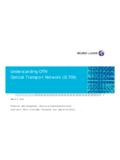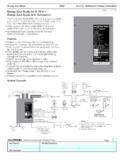Transcription of Introduction to Evolved Packet Core: Protocols and …
1 Kamakshi Sridhar, PhD Distinguished Member of Technical Staff Director Wireless CTO organization August 2012 Introduction to Evolved Packet core (EPC): EPC Elements, Protocols and procedures 2009 Alcatel-Lucent. All rights reserved. Agenda to Evolved Packet core (EPC) and Evolved Packet System (EPS) and all-IP: What is new? components Serving Gateway (SGW), PDN Gateway (PGW) Mobility Management Entity (MME), Policy and Charging Control Function (PCRF) core functions and service procedures core network functions Network attachment, service requests, paging, IP addressing, handover 2009 Alcatel-Lucent. All rights reserved. 3 | Technical Sales Forum | May 2008 1 Introduction to Evolved Packet core and Evolved Packet System 2009 Alcatel-Lucent. All rights reserved. LTE: All-IP, simplified network architecture New, all-IP mobile core network introduced with LTE End-to-end IP (All-IP) Clear delineation of control plane and data plane Simplified architecture: flat-IP architecture with a single core EPC was previously called SAE (System Architecture Evolution) eNodeB is also called E-UTRAN Evolved Packet System = EPC + E-UTRAN What is EPC ?
2 LTE+EPC eNode B IP channel Evolved Packet core (All-IP) Transport (backhaul and backbone) The EPC is a multi-access core network based on the Internet Protocol (IP) that enables operators to deploy and operate one common Packet core network for 3 GPP radio access (LTE, 3G, and 2G), non-3 GPP radio access (HRPD, WLAN, and WiMAX), and fixed access (Ethernet, DSL, cable, and fiber). The EPC is defined around the three important paradigms of mobility, policy management, and security. Source: IEEE Communications Magazine V47 N2 February 2009 REF: 4 | Introduction to EPC | July 2010 | v6 2009 Alcatel-Lucent. All rights reserved. Mobile core in 2G/3G 5 | Introduction to EPC | July 2010 | v6 2009 Alcatel-Lucent. All rights reserved. 7 | Technical Sales Forum | May 2008 2 LTE and EPC what is new? 2009 Alcatel-Lucent. All rights reserved. EPC: new all-IP core , new network elements (functions) EPC elements LTE/EPC eNode B IP channel MME PCRF PDN GW SGW GSM GPRS EDGE UMTS HSPA Evolved Packet core IP channel Packet Switched core PSTN Other mobile networks VPN Internet Voice Channels GGSN SGSN MGW MSC BSC / RNC Circuit Switched core (Voice) BTS Node B Softswitch GMSC 2G/3G Serving Gateway (SGW) Packet Data Network (PDN) Gateway (PGW) Mobility Management Element (MME) Policy and Charging Rules Function (PCRF) 8 | Introduction to EPC | July 2010 | v6 2009 Alcatel-Lucent.
3 All rights reserved. EPC elements EPC elements LTE/EPC eNode B IP channel MME PCRF PDN GW SGW Evolved Packet core Serving Gateway Serving a large number of eNodeBs, focus on scalability and security Packet Data Network (PDN) Gateway IP management ( IP anchor ), connection to external data networks; focus on highly scalable data connectivity and QoS enforcement Mobility Management Element (MME) Control-plane element, responsible for high volume mobility management and connection management (thousands of eNodeBs) Policy and Charging Rules Function (PCRF) Network-wide control of flows: detection, gating, QoS and flow-based charging, authorizes network-wide use of QoS resources (manages millions on service data flows) 9 | Introduction to EPC | July 2010 | v6 2009 Alcatel-Lucent. All rights reserved. LTE + EPC elements and interfaces MME PCRF SGW S5/S8 Gx S11 eNodeB eNodeB S1-U S1-MME S1-U X2 HSS S6a S10 PGW SGi Rx External networks Operator Services Applications IMS Internet ACPs EPC IP connectivity layer ( Evolved Packet System) = E-UTRAN + EPC UE Service Connectivity Layer CONTROL PLANE (CP) USER PLANE (UP) 10 | Introduction to EPC | July 2010 | v6 2009 Alcatel-Lucent.
4 All rights reserved. Flat IP = less hierarchy means lower latency eNode B Node B BTS data plane control plane data plane control plane SGSN PDSN RNC BSC GGSN HA SGSN PDSN RNC BSC GGSN HA GSM UMTS CDMA LTE MME S/P GW PGW SGW direct tunnel 11 | Introduction to EPC | July 2010 | v6 2009 Alcatel-Lucent. All rights reserved. Key implications on user plane (UP) and control plane (CP) User plane has many common attributes with fixed broadband Broadband capacity QoS for multi-service delivery Per-user and per-application policies Highly available network elements Control plane gets new mobile-specific attributes Mobility across networks (and operator domains) Distributed mobility management Massive increase in scalability Dynamic policy management WCDMA/HSPA GSM/GPRS/EDGE CDMA/EV-DO PDSN RNC RNC BSC SGSN/GGSN SGSN/GGSN eNode B IP channel LTE MME PCRF PDN GW SGW Evolved Packet core Service Delivery Platforms 12 | Introduction to EPC | July 2010 | v6 2009 Alcatel-Lucent.
5 All rights reserved. Serving Gateway Local mobility anchor for inter-eNB handovers Mobility anchoring for inter-3 GPP handovers Idle mode DL Packet buffering Lawful interception Packet routing and forwarding Policy, Charging & Rules Function Network control of Service Data Flow (SDF) detection, gating, QoS & flow based charging Dynamic policy decision on service data flow treatment in the PCEF (xGW) Authorizes QoS resources Quick Reference: Overview of EPC components and functionality interneteNBRB ControlConnection Mobility MeasurementConfiguration & ProvisionDynamic Resource Allocation (Scheduler)PDCPPHYMMES-GWS1 MACI nter Cell RRMR adio Admission ControlRLCE-UTRANEPCRRCM obility AnchoringEPS Bearer ControlIdle State Mobility HandlingNAS SecurityP-GWUE IP address allocationPacket Filtering eNodeB: all radio access functions Radio admission control Scheduling of UL and DL data Scheduling and transmission of paging and system broadcast IP header compression (PDCP) Outer-ARQ (RLC) Mobility Management Entity Authentication Tracking area list management Idle mode UE reachability S-GW/PDN-GW selection Inter core network node signaling for mobility between 2G/3G and LTE Bearer management functions PDN Gateway IP anchor point for bearers UE IP address allocation Per-user based Packet filtering Connectivity to Packet data network Policy PCRF Decisions 13 | Introduction to EPC | July 2010 | v6 2009 Alcatel-Lucent.
6 All rights reserved. All-IP mobile transformation RNC Radio intelligence moving to eNodeB 1 2 4 Node B BTS BS SGSN PDSN Backhaul (TDM/ATM) RNC bearer mobility evolves to the SGW 3 Backhaul transition to IP/Ethernet Backhaul (IP/Ethernet) MSC voice and Packet data switching evolve into the SGW RNC control distributed into the MME/eNB Packet data control evolves into the MME CS core 5 CS and PS evolve into a unified all-IP domain Service and mobile aware all-IP network Evolved Packet core MME PCRF PDN GW SGW eNodeB PS core GGSN HA Best effort to e2e QoS 6 7 Internet browsing to Web + 2G/3G LTE 14 | Introduction to EPC | July 2010 | v6 2009 Alcatel-Lucent. All rights reserved. LTE: more than an evolution for the Packet core Existing paradigm (3G) LTE Voice Circuit switched (CS) No (CS) core in LTE - e2e IP: VoIP (IMS), OneVoice - Through EPC: OTT, SR-VCC -Alternatives: CS fallback, VOLGA Broadband services Best effort, Limited expensive broadband Real-time, interactive, low latency, true broadband QoS Multisession data - Rudimentary in 3G (none in 2 ) - On request Based on service data flows (IP flows) - user-initiated sessions - network-initiated sessions QoS - Driven by UE -Control-plane intensive setup - theory: up to 8 CoS, practice: 2 4 (voice/control, best effort data) -Driven by policy management, not UE -Faster setup through EPC --9 QoS classes - End-to-end, associated with bearers Policy Management - PCRF introduced in 3 GPP R7 - Not widely adopted (static policy mgt used) Network-wide, dynamic policy charging and control (PCC) Mobility Management - Historically very much aligned (part of) with RAN - no RNCs - radio mgt.
7 By eNodeB - Mobility and session management important functions of the core 15 | Introduction to EPC | July 2010 | v6 2009 Alcatel-Lucent. All rights reserved. Example of UMTS QoS mapping to IP (transport perspective) Conversational Streaming Background Interactive Mapping UMTS traffic types to IP QoS (DiffServ Code Points) End-to-end QoS in UMTS 16 | Introduction to EPC | July 2010 | v6 2009 Alcatel-Lucent. All rights reserved. Flat-IP also implies need for a sound QoS mechanism 2G/R99 3G Access CS PS IP TDM LTE (and HSPA) EPC IP TDM IMS Dedicated radio resource allocation per user Shared radio resource allocation for all users PS resources CS resources Shared resources By nature, 2G and Rel99 3G legacy network architecture provides dedicated CS resources ensuring: Low latency (optimized for voice service) A guaranteed bit rate for the whole duration of the CS call (even in case of congestion) Without QoS control in flat-IP mobile networks, the end-user would experience ( for voice/video service): High latency when cell/network is congested High voice Packet loss when cell/network is congested Degraded perception for the end-user QoS control becomes mandatory to offer real-time services (Voice, Video or Gaming) over flat-IP mobile networks 17 | Introduction to EPC | July 2010 | v6 2009 Alcatel-Lucent.
8 All rights reserved. LTE QoS terms Service Data Flow = IP flow SDFs are mapped to bearers by IP routing elements (gateways) QoS Class Identifier (QCI) A scalar that is used as a reference to node specific parameters that control Packet forwarding treatment ( , scheduling weights, admission thresholds, queue management thresholds, link layer protocol configuration, etc.), and that have been pre-configured by the operator owning the access node Allocation and Retention Priority (ARP) The primary purpose or ARP is to decide if a bearer establishment/modification request can be accepted or rejected in case or resource limitation Guaranteed Bit Rate (GBR) Maximum Bit Rate (MBR) Aggregate Maximum Bit Rate (AMBR) (for non-GBR bearers) QCI + ARP + GBR + MBR + AMBR bearers 18 | Introduction to EPC | July 2010 | v6 2009 Alcatel-Lucent. All rights reserved. LTE QCI (QoS Class Identifier), as defined by 3 GPP QCI Resource Type Priority Packet Delay Budget Packet Error Loss Rate Example Services 1 Guaranteed Bit Rate (GBR) 2 100 ms 10-2 Conversational voice 2 4 150 ms 10-3 Conversational video (live streaming) 3 3 50 ms 10-3 Real-time gaming 4 5 300 ms 10-6 Non-conversational video (buffered streaming) 5 Non-GBR 1 100 ms 10-6 IMS signalling 6 6 300 ms 10-6 Video (buffered streaming) TCP-based ( , www, e-mail, chat, ftp, p2p file sharing, progressive video, etc.)
9 7 7 100 ms 10-3 Voice, video (live streaming), interactive gaming 8 8 300 ms 10-6 Premium bearer for video (buffered streaming), TCP-based ( , www, e-mail, chat, ftp, p2p file sharing, progressive video, etc) for premium subscribers 9 9 300 ms 10-6 Default bearer for video, TCP-based services, etc. for non-privileged subscribers From: 4 classes in UMTS and CDMA to: 9 classes in LTE One of LTE standards goals: backward compatibility with UMTS QoS 19 | Introduction to EPC | July 2010 | v6 2009 Alcatel-Lucent. All rights reserved. EPC bearer management Data plane needs to support fine-granularity of QoS and charging enforcement functions beyond transport / bearer level Uplink (UL) and Downlink (DL) Packet filters are defined for each bearer and QoS enforcements (policing, shaping, scheduling, etc.) are applied PGW acts as the Policy and Charging Enforcement Function (PCEF) point to maintain QoS / SLA for each of the bearers (and SDFs) eNodeB SGW PGW peer UE LTE-Uu S1 S5/S8 SGi End-to-end service EPS bearer External bearer Radio bearer S1 bearer S5/S8 bearer E-UTRAN EPC Internet 20 | Introduction to EPC | July 2010 | v6 2009 Alcatel-Lucent.
10 All rights reserved. 21 | Technical Sales Forum | May 2008 3 EPC elements 2009 Alcatel-Lucent. All rights reserved. eNode B MME SGW eNodeB (E-UTRAN) (not a part of the EPC), but let s look Interactions with other functional elements eNode B MME SGW UE eNode B Pool of SGWs Pool of MMEs Other eNodeBs Mobility Management Bearer handling Security settings Radio Resource Management Mobility management Bearer handling User plane data delivery Securing and optimizing radio interface delivery User plane tunnels for UL and DL data delivery Inter eNodeB handovers Forwarding of DL data during handovers User Equipment CONTROL PLANE (CP) USER PLANE (UP) 22 | Introduction to EPC | July 2010 | v6 2009 Alcatel-Lucent. All rights reserved. Mobility Management Entity MME controls how UE interacts with the network via non-access stratum (NAS) signalling Authenticates UEs and controls access to network connections Controls attributes of established access ( , assignment of network resources) Maintains EPS Mobility Management (EMM) states for all UE s to support paging, roaming and handover Manages ECM (EPS Connection Management) states eNode B IP channel MME is control plane element that manages network access and mobility MME PCRF PDN GW SGW Evolved Packet core 23 | Introduction to EPC | July 2010 | v6 2009 Alcatel-Lucent.







